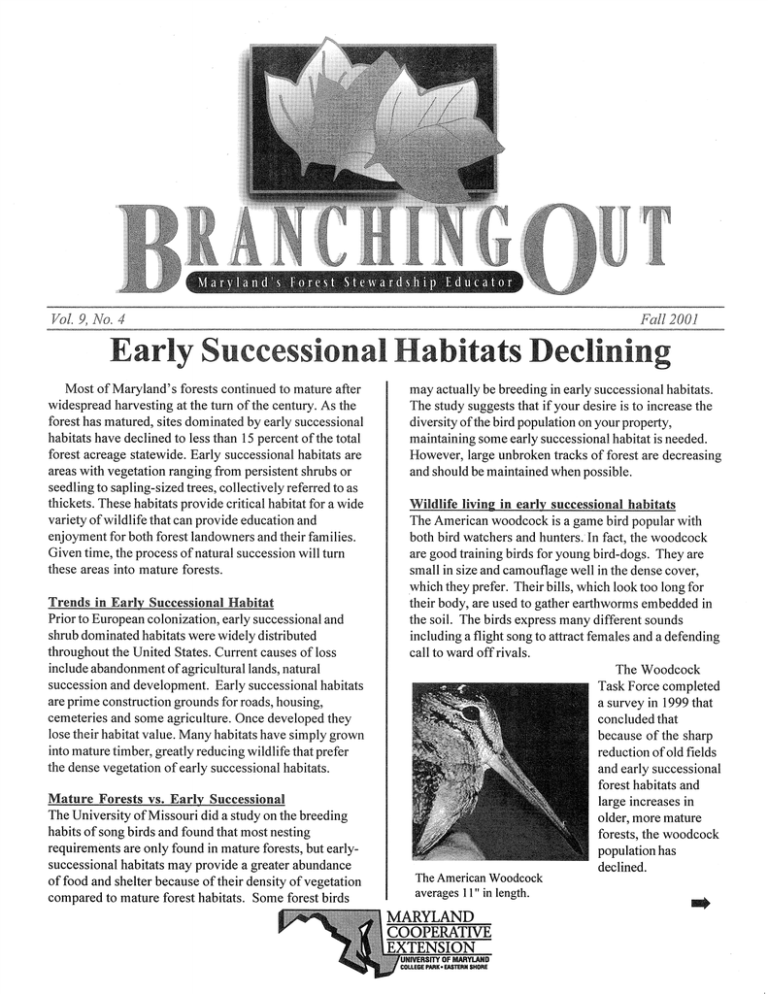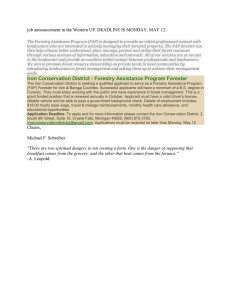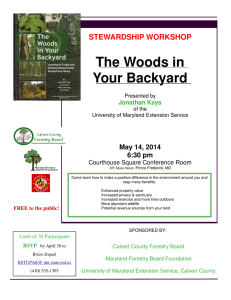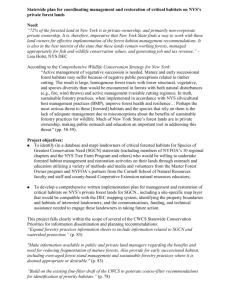Early Successional Habitats Declining 9, Vol. No.4
advertisement

Maryland's Forest Stewardship Educator Vol. 9, No.4 Fall 2001 Early Successional Habitats Declining Most of Maryland's forests continued to mature after widespread harvesting at the turn of the century. As the forest has matured, sites dominated by early successional habitats have declined to less than 15 percent of the total forest acreage statewide. Early successional habitats are areas with vegetation ranging from persistent shrubs or seedling to sapling-sized trees, collectively referred to as thickets. These habitats provide critical habitat for a wide variety of wildlife that can provide education and enjoyment for both forest landowners and their families. Given time, the process of natural succession will turn these areas into mature forests. Trends in Early Successional Habitat Prior to European colonization, early successional and shrub dominated habitats were widely distributed throughout the United States. Current causes of loss include abandonment of agricultural lands, natural succession and development. Early successional habitats are prime construction grounds for roads, housing, cemeteries and some agriculture. Once developed they lose their habitat value. Many habitats have simply grown into mature timber, greatly reducing wildlife that prefer the dense vegetation of early successional habitats. Mature Forests vs. Early Successional The University of Missouri did a study on the breeding habits of song birds and found that most nesting requirements are only found in mature forests, but earlysuccessional habitats may provide a greater abundance of food and shelter because of their density of vegetation compared to mature forest habitats. Some forest birds may actually be breeding in early successional habitats. The study suggests that if your desire is to increase the diversity ofthe bird population on your property, maintaining some early successional habitat is needed. However, large unbroken tracks of forest are decreasing and should be maintained when possible. Wildlife living in early successional habitats The American woodcock is a game bird popular with both bird watchers and hunters. In fact, the woodcock are good training birds for young bird-dogs. They are small in size and camouflage well in the dense cover, which they prefer. Their bills, which look too long for their body, are used to gather earthworms embedded in the soil. The birds express many different sounds including a flight song to attract females and a defending call to ward off rivals. The Woodcock Task Force completed a survey in 1999 that concluded that because of the sharp reduction of old fields and early successional forest habitats and large increases in older, more mature forests, the woodcock population has declined. The American Woodcock averages 11" in length. • Ruffed grouse are brownish colored birds that are somewhat larger than pigeons, ranging from 17 to 25 oz., that require early successional forests. The males are the most spectacular with long, shiny black or chocolate feathers that extend to make the bird look twice its size. During breeding season, the males will proclaim their territory by "drumming;' their wings while standing on a "stage" of a fallen log, stone or mound of dirt. Drumming occurs throughout the year. Other wildlife found to prefer early successional habitats include the golden winged warbler, chestnutsided warbler, prairie warbler and yellow-breasted chat. Many plant species such as milkweed and butterfly weed found in thickets are used as nectar sources for butterflies such as monarchs and the tiger swallowtail. Creating early successional habitats Forest landowners who work with a registered professional forester can develop a stewardship plan that will create or maintain early successional habitats. The physical properties include intense light from the lack of a closed canopy, high temperatures and low soil moisture. The creation of early successional habitats can be accomplished by sound forest harvest practices. It is recommended that forest landowners identify proper sites by looking at the successional landscape around them. South-facing slopes are good choices because these tend to receive more sunlight and remain free from snow for longer periods of time. The typical procedure for creating these habitats is by clearcutting forests. Landowners should not be dismayed or persuaded by the mainstream notion that sound clearcutting practices are damaging to the environment. The creation of this new environment will support an incredible diversity of wildlife and vegetation. Another technique is field border management which entails removing trees along existing fields for a distance of 100 feet into the forest. A few mast producing trees can be left for wildlife and the edge habitat created is excellent. Still another option is to remove trees that invade existing old fields to maintain the early successional habitat. necessary if they are shading brush or stunting the growth of younger trees. • Prescribed burning will result in a renewed and healthier habitat. • Herbicides can be used to manipulate habitats by controlling weeds, reducing competition and by improving the overall diversity. • Mow existing old fields to create a mix of habitats, but mow no more than 1/3 of the entire area. • Avoid establishing new areas with cool season grasses. Establish native warm season grasses and mow no shorter than 6 inches. • Mowing should be performed in the early spring (March - early April) prior to the nesting season that follows. • Prescribed light grazing is recommend for owners who fully understand the grazing system. It's important that landowners take an active role in managing early successional habitats. It's critical to the life of these ecosystems that humans intervene so that we can enjoy the full rewards they have to offer. _ Working Towards Sustainable Havesting Methods A well-executed timber sale should include the forest landowner, a professional forester and a competent logger. Since most landowners know little about the timber business, they are encouraged to use a licensed professional forester to represent their interests in the sale. Before a sale takes place, a forest landowner should have a professional forester help them develop a forest stewardship plan that will guide their management activities to meet their objectives and provide for the sustainability of their forest resources. Foresters and loggers should be seen as professionals, Managing early successional habitats The following provides maintenance suggestions for newly established or already existing habitats: • Focus creation and enhancement of early successional habitat along existing edges. • While shrubs and trees can be planted, the most cost-effective way is to let nature take its course and put your dollars into other management activities. • Thinning large trees near managed edges may be Page 2 ----------www.naturalresources.umd.edu but what can you do if you feel their services were not professional? If you have issues with specific regulatory requirements such as erosion or sediment control, you should call your local officials. However, where can you register a complaint regarding specific business or forest harvest practices? In addition to the Better Business Bureau, the following suggestions are provided: Professional Foresters Foresters are of three types: state foresters, private consultant foresters and industrial foresters. To become licensed in the state of Maryland, a forester must be a graduate of a four-year forestry curriculum and have two years of practical experience. The candidate must then submit five recommendations, three of which must be from foresters who can vouch for the applicant's ability and character. Foresters must abide by a strict code of ethics upheld by the Society of American Foresters; the national professional organization for foresters. In addition, continuing education credits are required to renew the professional forester license. Landowners who feel that a licensed forester has not served in their best interest may register a complaint with the Board of Forester Licensing. A complaint form may be obtained by calling the Board Office at 410-2306222 or by submitting a letter in writing to: DLLR (Department of Labor, Licensing and Registration), Board of Forester Licensing, 500 N. Calvert St., Rm. 304, Baltimore, MD 21202, or on the Internet at www.dllr.state.md.usllicense/occprof/forest.html. Once a complaint has been received, the following occurs: • A DLLR investigator contacts and interviews all parties involved and then submits a report to the complaint committee. • The complaint committee either closes the case without action or recommends review by the Office of the Attorney General. • Ifa violation of the law has been committed, the hearing may take place before the State Board of Foresters who has the ultimate authority to issue a reprimand or may suspend or revoke a forester's license. In the past, most complaints have been filed against people who don't have a professional forester license, but represent themselves as foresters. As of November, 2001, any person who is found guilty by the district court of practicing forestry without a license will be subject to a fine up to $5,000. For a list of licensed foresters, contact your local Department of Natural Resources Service Forester or log onto: Http://www.dnr.state.md.us/forests/oflists/ saif.html. Loggers When landowners sell timber using a private consultant forester, many loggers or timber companies may submit competitive bids. Consider using a Maryland Master Logger current in his training. This voluntary training program offers instruction in forest management principles, forest ecology, proper harvest design and layout, safety practices and lifesaving skills. In addition to the training courses, Master Loggers must attend one continuing education course on a related topic per year. This ensures that Master Loggers are up-to-date on the most recent laws and techniques in the industry. Combining the suggestions in a forest stewardship plan from a professional forester with the skills of a Maryland Master Logger offers you the best potential from your land. In the event that you are not satisfied with the work ofthese logging professionals, the Maryland Forest Association is prepared to accept complaints from landowners. The phone number to call to register a complaint against a company enrolled in the Sustainable Forestry Initiative (SFI) program is 301-8955369. The complaint will be turned over to the Maryland Implementation Committee who will examine the operation and forward their findings to the landowner and the SFI member company if appropriate. Since the Maryland Master Logger is an education based program, the Maryland Forest Association doesn't have the authority to revoke licenses or issue fines. For more information on the Maryland Master Logger Program, contact the Maryland Forest Association at 301-895-5369. Some logging companies who do business in Maryland are from other states and may not be involved with the Maryland Master Logger program. One forest industry trade group that timber companies have the option of joining is the American Forest & Paper Association® or AF&PA. AF&PA members have created the Sustainable Forestry Initiative (SFI), which is a comprehensive forest management program based on responsible environmental and business practices. These practices promote the practice of sustainable forestry. If you have a complaint against an AF&PA member, you can fill out an SF! Program Inconsistent Practices Form that can be found on their website at http:// www.afandpa.org/forestry/sfi frame.html. tlt - - - - - -_______ www.naturalresources.umd.edu _________ Page 3 Upcoming Stewardship Events Take Note • New Price for bare-rooted American Chestnut seedlings for distribution is now under way. Cost is $30 per bundle of 50, including mailing. Orders of25 or fewer will cost $15. For information, visit accf-online.orglgreport.htm. • Copies of the Ninth Wildlife Damage Management Conference are available for $15.00 from Penn State University by calling 814-865-7050. This 372-page resource contains results and data on research projects involving wildlife damage management. • Learn to manage your wood lots for timber products, Wildlife and overallforest health with the General Forestry Correspondence Course conducted by Maryland Cooperative Extension specialists. Work from home with a notebook of lessons and supplemental readings. Cost is $150. For more information, call Nancy Stewart at 41 0-827-8056 or e-mail her at ns111@umail.umd.edu. • The Maryland Tree Farm System is trying to update their mailing list. If you are a Certified Tree Farmer and are not receiving MTFS mailings, need a Tree Farm sign or would like a "Wood is Good" bumper sticker, call Howard Anderson at 301855-0927. • Taxes and Land Preservation, Computing the Capital Gains Tax, FS-780, is available. The fact sheet briefly describes different programs available to assist in the preservation of farmland and to purchase certain rights connected to the land for cash. To receive your copy, contact your local Maryland Cooperative Extension. For past Brancing Out newsletters, stumpage price reports and more, visit: www.naturalresources.umd.edu Branching Out - Vol. 9, No.4, Fall 2001 Please send changes of address. See page 2 for addresses and phone number. Feb. 2: 18th Delmarva Forestry Seminar, Polytech Adult Education Center, Woodside, DE, 8:30 a.m. This year's theme is "Forestry ... How it is all Connected." Contact Dot Abbott-Donnelly, 302-730-4000. March 16: Income Opportunities Conference, Adams County Cooperative Extension, Gettysburg, 8:30 a.m. 4 p.m. The morning session will cover such topics as fee fishing, mushrooms and ornamental aquaculture. The afternoon breakout sessions will cover various business issues. Contact Steve Bogash, 717-263-9226. Coverts complete their training For three days in September, 24 volunteers used their weekend to learn how to better manage their properties by participating in a training seminar sponsored by Maryland Cooperative Extension and the Ruffed Grouse Society. All Covert Cooperators sign an agreement that, after their training, they will: (I) implement a stewardship plan prepared by a professional forester or will review their plan should they already have one and (2) share what they learned with members of their community. Through this network of over 300 cooperators, we hope to teach thousands of woodland owners how to practice sound forest and wildlife management. For more information on the Coverts Project or to fill out an application, please visit our web site at: www.naturalresources.umd.edu. • The Partnership for a Sustainable Forestry is a number of forestry related organizations who have come together to identify common forestry concerns and discuss ways to collectively pursue common solutions. The group has plans to publish position papers regarding Maryland's forest resources, to educate state policy makers and legislators and to conduct an educational forum on forestry issues. Co-coordinators of the Partnership are Jim Mallow, retired State Forester, and Gary Allen, chair of the Forestry Task Force. Issued in furtherance of Cooperative Extension work, acts of May 8 and June 30, 1914, in cooperation with the U.S. Department of Agriculture, University of Maryland, College Park, and local govemments. Thomas A. Fretz, Director of Maryland Cooperative Extension, University of Maryland. The University of Maryland is equal opportunity. The University's policies, programs, and activities are in conformance with pertinent Federal and State laws and regulations on nondiscrimination regarding race, color, religion, age, national origin, gender, and disability. Inquiries regarding compliance with TItle VI of the Civil Rights Act of 1964, as amended; Title IX of the Educational Amendments; Section 504 of the Rehabilitation Act of 1973; and the Americans With Disabilities Act of 1990; or related legal requirements should be directed to the Director of Human Resources Management, Office of the Dean, College of Agriculture and Natural Resources, Symons Hall, College Park, MD 20742. MARYlAND COOPERATIVE EXTENSION U. S. DEPARTMENT OF AGRICULTURE UNIVERSITY OF MARYLAND COLLEGE PARK, MARYlAND 20742 OFFICIAL BUSINESS PENALlY FOR PRIVATE USE $300 Return Service Requested PRESORTED POSTAGE &FEES PAID USDA PERMIT NO. G268




